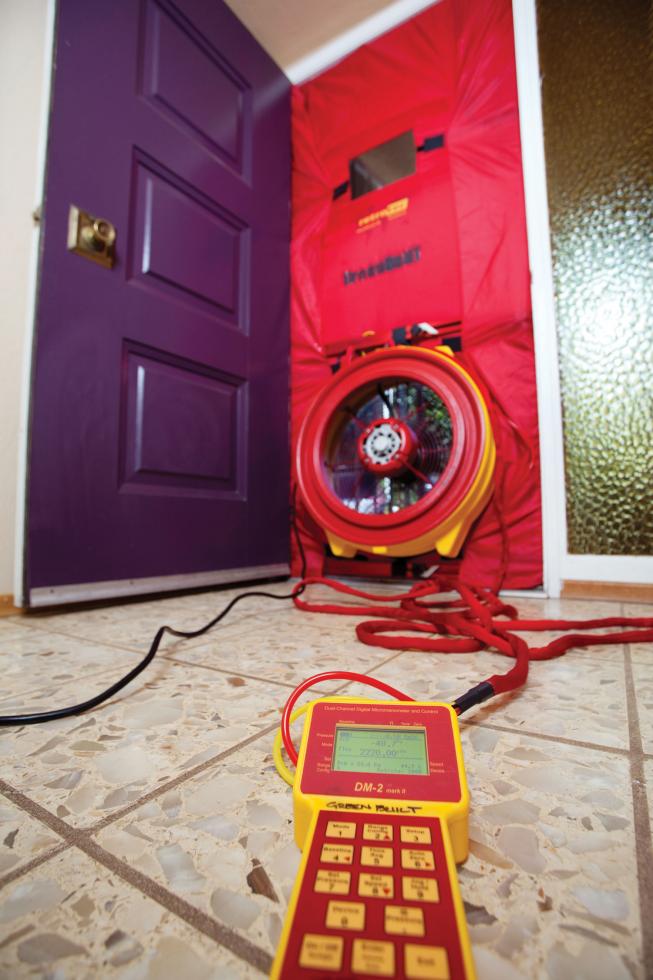When California’s building industry began to crumble in 2008 — with 2009 producing the lowest number of homes built since 1954 — veteran contractors like Jim Bayless scrambled to reinvent themselves.
Only 36,421 residential homes were built in California in 2009, a nose dive from the 2004 peak of a whopping 212,960 units, according to the Construction Industry Research Board. The bleak scenario, which had been unfolding since 2007, led Bayless to close Treasure Homes in 2008 and invest in the emerging energy-efficient retrofit business.
“Doing energy-efficient retrofits on homes is very different from being a production homebuilder,” Bayless says. “It was a big adjustment.”
Greenbuilt Construction, Bayless’ Folsom-based venture, focuses on sustainable building and energy efficiency. A SMUD Home Performance Program-approved contractor, much of Bayless’ business involves evaluating the energy efficiency of homes and helping homeowners make improvements to conserve and cut utility costs.
The path from homebuilder to energy-efficient retrofitter has been a long journey for Bayless. Performing retrofitting for Sacramento Municipal Utility District or Pacific Gas & Electric Co. customers required Bayless (who already had a general contractor’s license) to get trained and certified as a building analyst through the Building Performance Institute.
The institute’s building analyst training can take anywhere from five to nine days, plus exams and field testing through Sacramento, Stockton and Bay Area organizations such as ConSol, Build It Green, California Building Performance Contractors Association and Sierra Building Science Inc. Training and testing ranges $4,000 to $5,000 per person, depending on the certifications sought.
Jeff Connor, owner of Sacramento Building Performance, took the institute’s building analyst training through Sierra Building Science in 2009, when his custom-home business plummeted 50 percent. The environmental aspect of making homes more efficient was appealing to him, plus recent legislation such as Assembly Bill 32 and federal stimulus money convinced him to shutter JM Connor Construction and open Sacramento Building Performance.
“It was a leap, especially with the economy taking a dive, but I saw the writing on the wall.” Connor says. “You could see things were going in the green direction.”
Lead building scientist for Loomis-based JLS Home Experts, Scott Blunk recognized the moneymaking potential of energy-efficiency retrofitting for residential contractors. Former owner of Green Building Scientist Corp. and a current BPI trainer, Blunk joined JLS as a consultant over a year ago to launch its energy retrofitting division. Since January he has led the department full time.
“I was aware of what was happening in the home-performance building arena, and I knew energy retrofitting was coming,” Blunk says. “A few years ago, I took a consultant to a Building Industry Association event where they were talking about Assembly Bill 811, and I told him that it would offer a lot of opportunity.”
In 2008, the Legislature passed AB 811, allowing California cities and counties to help homeowners finance energy-efficiency improvements via low-cost loans repaid through their property tax bills. AB 32, the California Global Warming Solutions Act of 2006, mandates that California’s greenhouse gas emissions be reduced to 1990 levels by 2020. What’s more, energy-efficiency retrofitting has sprung from a portion of the $2.8 billion in stimulus funds from the Energy Efficiency and Conservation Block Grant Program, part of the American Recovery and Investment Act of 2009.
Single and multifamily homes are responsible for 14 percent of California’s greenhouse gas emissions, according to a 2008 study by ConSol, a national residential building energy consultant located in Stockton. And 70 percent of those emissions are generated by homes built before 1983, prior to the state establishing an energy code.
Since existing homes produce the bulk of residential greenhouse emissions (homes built after 2006 account for only one-tenth of 1 percent), energy-efficient retrofitting is crucial to meeting AB 32 standards. Convincing homeowners to make energy retrofit improvements, however, is a hurdle that contractors are struggling to conquer.
Lack of homeowner education is one reason John Eisele of Eisele Construction Inc. in Davis is reluctant to pursue energy retrofitting, even though he has an analyst certificate from the institute. He knows most people think energy upgrades mean caulking, insulation or installing new windows, while in reality retrofitters use cutting edge software to assess homes for energy leaks and then find the most efficient solution to the problem. They often seal attics and replace duct systems to save energy.
“When the kinks are worked out and people understand what energy retrofitting is, I’ll consider it,” Eisele says. “There’s too much confusion. The government and utility companies haven’t streamlined their programs, and the paperwork is a nightmare.”
As a Davis contractor, Eisele falls under PG&E’s jurisdiction, where the utility offers its energy-efficiency retrofitting program solely under the umbrella of Energy Upgrade California. Developed by a consortium of counties, cities, government agencies and utilities (including PG&E and SMUD), the Energy Upgrade California website, energyupgradeca.org, is a one-stop hub where homeowners can learn about energy upgrades, available rebates and locate certified contractors.
Single and multifamily homes are responsible for 14 percent of California’s greenhouse gas emissions, according to a 2008 study by ConSol.
PG&E spokesperson Katie Romans says contractors are required to submit customer and contractor information in addition to test-in and test-out data for the utility to validate and process rebates for customers.
“We are always looking for ways to automate and streamline our submission processes to make it easier for program participants,” Romans says.
In addition to working with Energy Upgrade California, SMUD has developed its own Home Performance Program. With customer inquiries mounting and 37 trained contractors who can perform assessments and do energy retrofit improvements, Program Manager Jim Mills is optimistic about its success.
SMUD created the program to help local contractors and, hopefully, reduce future energy demands on the grid. So far, 300 customers have done the energy evaluation, contractors have completed 35 retrofit projects and 75 more are on the books.
“We hoped by putting some really large customer rebates on the market, we could stimulate the economy by getting customers to upgrade the efficiency of their homes,” Mills says. “Then, the contractors go back to work and hire other people.”
To assist contractors with training, SMUD has partnered with Cosumnes River College to offer a two-part, 16-week program in which graduates earn a Building Performance and Energy Assessment Certificate. This training prepares contractors and construction workers for the Building Performance Institute’s building analyst and envelope certification tests. Although tuition and books run about $1,000, grants allow most students to attend free.
Ryan Connally, professor of construction technology and head of the Cosumnes River training program, says the college launched the program more than a year ago because of a growing need for skilled retrofit workers.
And business is certainly booming for Comfort City Inc. owner Dan Cronk. He sees energy retrofitting as the best way to make a living since he was forced to close Placerville-based Live Oaks Construction, which he founded in 1986.
“My forte was room additions and second stories where people relied on their home equity to finance the work,” Cronk says. “Everybody lost the equity in their homes. I went from doing $800,000 down to zero in eight months.”
After the demise of Live Oaks in 2008, Cronk tried to succeed in the crowded and competitive solar business for a few years before learning about SMUD’s Home Performance Program. In February 2010, he started taking classes to get certified as one of SMUD’s approved retrofitting contractors and to participate in the Energy Upgrade California program to serve PG&E customers.
Cronk’s road to retrofitting was bumpy. He lost his life savings and the four-bedroom custom home outside Placerville that sat on 10 acres. He moved his wife and three kids to a rental home, sold his boat and tractor and borrowed money to fund the launch of Comfort City in June 2010.
With just $25,000, Cronk and partner, Nathan Cole, had to buy energy assessment equipment and get retrofit training for themselves and their employees. They nabbed second-hand equipment for $12,000 and spent $3,000 on a website. Slowly, they began getting clients through the SMUD Home Performance and Energy Upgrade California programs.
Marketing efforts funded by SMUD and PG&E through Energy Upgrade California are aimed at educating homeowners on the benefits of energy retrofits via website, bill inserts, magazine ads and radio and TV commercials. Later, Cronk spent $20,900 of his own money attending the Sacramento and Auburn home shows, buying radio ads, making a power video for the Internet and doing door-to-door canvassing, leaving flyers and making appointments.
Offering customers free energy-efficiency assessments paid off in a stream of retrofit jobs and steady profit for Cronk. SMUD pays $400 to Cronk and fellow contractors for the initial assessments, courtesy of a $20 million federal grant awarded to the Home Performance Program, leaving a $99 cost for homeowners. PG&E offers no subsidies to help cover the $500 contractors typically charge for testing.
The energy retrofitting business is also picking up for JLS Home Experts, Greenbuilt and Sacramento Building Performance. All three contractors are now breaking even financially and hope to make a profit next year.
For JLS Home Experts, launching the energy-efficient retrofitting branch of their business cost about $100,000, including training and certification for employees.
Connor spent about $35,000 to get Sacramento Home Performance up and running. He and his wife built the website and used the Internet for marketing through blogging and links. Was all the time, effort and money worth it? Connor thinks it will be. Most of his clients are coming from SMUD and the U.S. Housing and Urban Development.
Eisele is sticking to remodeling for now, shelving his analyst certificate. Eventually, he would like to do energy retrofitting, but he worries a future lack of funding from government budget cuts may kill customer rebates, utility programs and, ultimately, the entire business.
On the flip side, Blunk sees a promising future. A portion of AB 32 allows California cities and counties to mandate a whole house Home Energy Rating System number on every home sold. Berkeley is the first city to require this energy-efficiency rating on houses, similar to the miles per gallon stickers on cars. More cities are likely to follow, requiring energy-efficiency testing on all homes.
“We don’t know what it will look like yet,” Blunk says. “They may require just the test and a whole house rating, or they could mandate that the home be brought up to some level of energy efficiency. I think more business will come from fixing things found in testing.”
Recommended For You

The Green Flash
There's energy in Solano's technology sector
An influx of green manufacturing companies and a burgeoning renewable-energy sector is creating the critical mass Solano County needs to usher in a new era of competitive economic growth.

Energy-Efficient Opportunities
Making lemonade out of greenhouse gas mandates
Late last year, California held the nation’s inaugural cap-and-trade auction, where greenhouse gas emission permits were sold in an effort to monetize and reduce carbon pollution. And just last month, new cap-and-trade regulations on large power and industrial plants officially went into effect.



